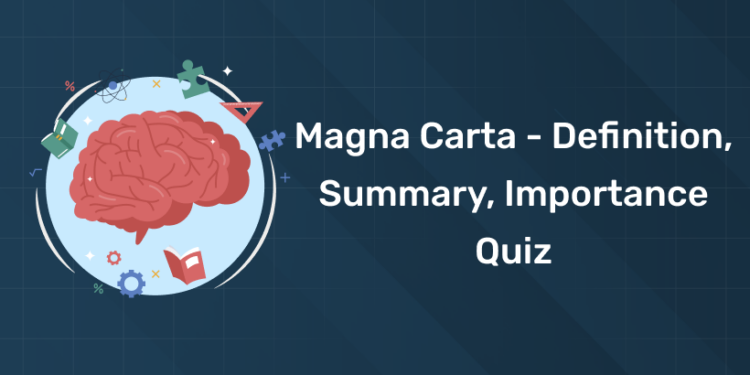Magna Carta Libertatum (Medieval Latin for “Great Charter of Freedoms”), commonly called Magna Carta is a foundational document in English legal history. It was originally issued by King John of England in 1215 at Runnymede Grounds under pressure from his barons, who were seeking to limit the monarch’s power and protect their own rights. It promised the protection of church rights, protection for the barons from illegal imprisonment, access to swift and impartial justice, and limitations on feudal payments to the Crown. Neither side stood by their commitments, and the charter was annulled by Pope Innocent III, leading to the First Barons’ War.
Magna Carta Summary
The Magna Carta contains a series of provisions that address various grievances and concerns of the barons against King John’s rule. Some key provisions include guarantees of due process, protection against arbitrary imprisonment, and limitations on royal taxation without consent. It also established the principle that the king is subject to the law, rather than above it.
Key Points
- Magna Carta – signed by King John on 15th June 1215 at Runnymede Grounds.
- The Habeas Corpus Act 1679 is an Act of parliament in England during the reign of Charles II.
- William Pitt described it as “the Bible of the English Constitution”
- Winston Churchill called it “the most famous milestone of our rights and freedoms”.
- Franklin Roosevelt said “the democratic aspiration …was written in Magna Carta”.
- Magna Carta, also known as the Great Charter and the Royal Charter.
- Petition of Rights – 1628 June 7
Magna Carta Importance
The Magna Carta is significant for several reasons:
- It marked a crucial step towards the establishment of the rule of law and the protection of individual rights.
- It laid the foundation for constitutional government and the idea of a contract between the ruler and the ruled.
- It influenced later legal documents and constitutional developments in England and other countries.
- It symbolizes the principle that even the king is bound by law and must respect the rights of his subjects.
- The Magna Carta established a limit to the taxation of a king’s people
- It established the barons’ rights to their land.
- Magna Carta also set a precedent for the move toward democracy in Europe.
Magna Carta History
The first version of Magna Carta was issued in 1215 at Runnymede by King John. Increased taxes, the king’s excommunication by Pope Innocent III in 1209 and his unsuccessful and costly attempts to regain his empire in Northern France had made John hugely unpopular with his subjects. Whilst John was able to repair his relationship with the Pope in 1213, his failed attempt to defeat Phillip II of France in 1214 and his unpopular fiscal strategies led to a barons’ rebellion in 1215. In June 1215, under pressure from his barons, King John reluctantly agreed to a set of demands known as the Articles of the Barons. These demands were later incorporated into a formal document called the Magna Carta, which was sealed by the king at Runnymede, near Windsor Castle, on June 15, 1215.
Despite being sealed by King John, the Magna Carta was not fully implemented during his reign. However, it laid the foundation for future constitutional developments in England. Following King John’s death in 1216, his successor, King Henry III, reissued the Magna Carta in an amended form in 1217.
Who wrote Magna Carta?
The leaders of the baron uprising met with their monarch and presented him with a document that they had written. Several of the individuals involved in writing and consulting on the document are actually listed in the Magna Carta’s preamble. They include the noblemen William Marshal, Alan of Galloway, Waren Fitz Gerold, Peter Fitz Herbert, Hubert De Burgh, Hugh de Neville, Matthew Fitz Herbert, Thomas Basset, Alan Basset, Philip d’Aubigny, Robert of Roppesley, John Marshal, John Fitz Hugh, and a number of others. King John, who signed the Magna Carta at the barons’ behest, did not actually write the document.
Clauses still in force today
The clauses of the 1297 Magna Carta which are still on statute are
- Clause 1, the freedom of the English Church.
Clause 9 (clause 13 in the 1215 charter), the “ancient liberties” of the City of London.
Clause 39 (clause 39 in the 1215 charter), a right to due process:
“No free man shall be arrested, or imprisoned, or deprived of his property, or outlawed, or exiled, or in any way destroyed, nor shall we go against him or send against him, unless by legal judgement of his peers, or by the law of the land.”
Magna Carta – Quiz PDF
Download Magna Carta Quiz PDF for free!
Magna Carta Quiz
- When was the Magna Carta originally issued?
- A) 1066
- B) 1215
- C) 1492
- D) 1776
- What was the primary purpose of the Magna Carta?
- A) To establish a monarchy
- B) To limit the power of the king
- C) To expand the authority of the Church
- D) To abolish feudalism
- Which English king issued the Magna Carta?
- A) Richard the Lionheart
- B) Henry VIII
- C) King John
- D) Edward I
- What principle did the Magna Carta establish regarding taxation?
- A) The king could impose taxes without limit
- B) The barons could impose taxes on the king
- C) The king could only impose taxes with the consent of the nobles
- D) Taxation was abolished entirely
- What is the significance of the Magna Carta?
- A) It established the divine right of kings
- B) It laid the foundation for constitutional government
- C) It abolished the monarchy
- D) It established the supremacy of Parliament












